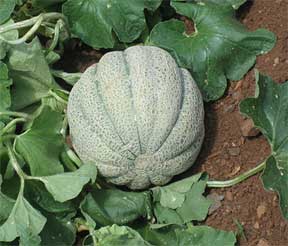Sometimes it is difficult to grow cantaloupes (muskmelons) in a small garden, but even a small vegetable plot can provide space for a few hills. When you make your garden plan, on paper or in the actual garden, allow two rows for onions, radishes, and other early maturing crops. Then leave one or two rows for cantaloupes (depending on the space you can afford), and plant two more rows of quick growing vegetables. When these early vegetables are harvested, the empty rows leave spreading room for the melons.
In the cantaloupe rows, dig holes 18 inches deep, about three feet apart. Fill each hole about half full of good compost, or partially rotted manure. Cover this with four or five inches of dirt, leaving the hole lower than the surrounding ground. In the center of the hole, plant five or six seeds, covering them with about an inch of fine soil. Later, thin to two or three sturdy plants per hill.

Seeds can be planted in the open ground as soon as all danger from frost is past. Here in New Mexico, we plant around the 15th of April.
Melons prefer a sandy soil and lots of water. I like to lay the water hose in each depression, and let it run slowly until the hole is filled. When plants start to spread, cover the ground with any mulch that is available. This keeps moisture in, the ground cooler, weeds from growing, and results in cleaner vines and melons.
Muskmelons should be left to ripen on the vine, until they come off easily when given a slight tug or twist. With some experience, you can learn to discern the ripe ones by their delicious aroma.
Watermelons and winter squashes may also be grown in the small garden by using the methods used for muskmelons.
